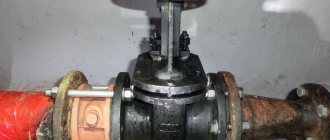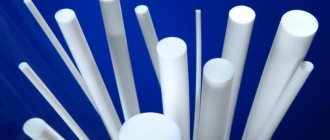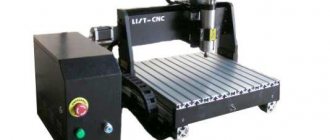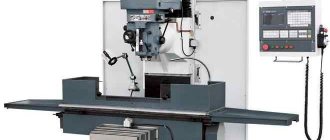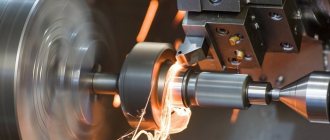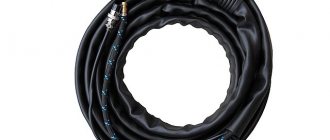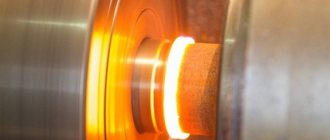What are carbide inserts?
Carbide inserts are tools used for precision machining of metals, including steel, stainless steel, cast iron, high-temperature alloys, and non-ferrous metals. They are interchangeable and come in different styles, grades and sizes.
There are a few basic considerations when choosing the right carbide inserts. One of these is the cutting operation, whether turning, milling or drilling. Carbide is more expensive per unit than other typical tool materials and is more brittle, making it susceptible to chipping and fracture. To overcome these problems, the carbide cutting tip itself is often shaped like a small plate for a larger tipped tool whose shank is made of a different material, usually carbon tool steel. This offers the advantage of using carbide at the cutting interface without the high cost and brittleness of making the entire tool from carbide. Most modern face mills use carbide inserts, as well as a variety of turning and end mills.
Inserts are used at high speeds, resulting in faster processing and ultimately improved finishing. Selecting the correct carbide insert is vital as it can cause damage to the cutting inserts, the machine and the cutting product.
How are the plates marked and who produces them?
By marking carbide structures for turning tools, you can determine the composition of the production material. In particular, the T15K6 marking means that the product is made on the basis of an alloy of the titanium-tungsten-cobalt group. Tungsten is mandatory in these alloys. In addition to tungsten, the alloy must additionally contain:
- tantalum;
- cobalt;
- titanium and others.
The composition of such an alloy, in accordance with the marking, contains titanium carbide in the amount of 15 percent and cobalt in the amount of 6 percent, respectively.
The most well-known manufacturers of these products used for mechanical fastening on cutters are:
- Ceratizit (Luxembourg);
- BDS-Machinen and Proxxon (Germany);
- Instrument-Service and Novomoskovsk Pipe Plant (Ukraine).
What's good about carbide inserts?
Here are some of the reasons why carbide inserts are so good compared to other cutting tools:
- Carbide inserts are efficient and economical compared to other similar cutting tools.
- Some carbide inserts, such as tungsten, are highly durable and increase service life.
- Carbide inserts come in different shapes and grades that can be used in various applications.
- Carbide inserts provide much better surface quality than other tools.
Manufacturing of carbide inserts
Let's take a look at the carbide insert manufacturing process to better understand its types and uses;
The right carbide insert for specific machining applications helps you stay ahead of the competition among cutting tool manufacturers.
Carbide inserts, mainly tungsten and cobalt, are supplied in powder form. The dry raw material is then mixed with a mixture of ethanol and water. The result is a gray slurry with the consistency of a yogurt drink. This mixture is dried and then sent to a laboratory for quality testing. This powder consists of agglomerates, small balls with a diameter of 20 to 200 microns, and is then transported to pressing machines where the inserts are made.
Carbide insert geometry
Carbide insert geometries can be divided into three main styles, optimized for several applications including roughing, finishing and medium cutting. Here are some diagrams that explain the working area of each geometry based on geometric chip breaking taking into account the depth of cut.
Roughing
Roughing involves a combination of high depth of cut and feed rate. This process requires maximum edge security.
Roughing
Finishing
Finishing involves watery depth of cut and low feed rates. This process requires low cutting forces.
Finishing
General processing
This operation includes a wide range of deep cut and feed speed combinations.
General processing
Entry Angle for Carbide Inserts
Leading angle KAPR (or leading angle PISR) is the angle between the cutting edge and the feed direction. It is important to select the correct approach/ascent angle for successful turning. The approach/lead angle affects:
- Chip formation
- Direction of cutting forces
- Cutting edge length in section
The role of geometry in plate production
When the role of geometry is discussed, people generally consider the macrogeometry and physical form of the carbides. Equally important here is microgeometry, which concerns the cutting edge of a microscopic shape.
Carbide insert geometry
Insert geometry is an important aspect as it affects the chip breaking pattern. Various shapes and angles provide optimal results in chip crushing depending on the material and application.
With the help of advanced technologies, the cutting surface of the plate is given a round, oval or any other geometric shape. Significant benefits in insert life and stability have been seen with the advent of new technologies. It is safe to say that future technological progress will stimulate further development in this field and even more significant achievements will be achieved.
Classification of carbide inserts
Most cutting tools consist of two parts: the holder and the cutting edge. The holder attaches the cutter to the machine, and the edge directly removes chips from the workpiece. It is precisely carbide plates that are used as the material for the cutting edge.
There are many factors that affect the efficiency of the cutting process. This includes the workpiece material, serial production, type of cooling, etc. Depending on this, there are many types of instruments. To put it simply, they are classified according to the type of alloy from which the plate is made and the method of attachment to the holder. Let's now look at each category in more detail.
Types of plates by material type
In most cases they are made from:
- Tungsten-cobalt alloy.
- Titanium-tungsten-cobalt alloy.
- Titanium-tantalum-tungsten-cobalt alloy.
- Titanium carbide alloy.
1. Carbide inserts based on tungsten and cobalt are recommended for cutting materials that produce chips. This category includes copper and aluminum alloys, cast iron and plastics. This variety is characterized by increased wear resistance and is used for finishing milling with the highest possible cutting speed, but the depth of cut and feed are quite low.
All types of tungsten-cobalt plates have high strength properties. The bending strength ranges from 1175-1470 MPa. Hardness reaches up to 75 units on the Rockwell scale.
Increasing the amount of cobalt in the composition of the plates has a positive effect on their mechanical characteristics. In particular, there is an increase in bending strength, ductility and toughness.
2. A plate made of titanium-tungsten-cobolt alloy is intended for cutting metals that produce drain chips. Compared to the above plates, it has reduced thermal and electrical conductivity, but at the same time it is ahead of them in terms of oxidation resistance, hardness and heat resistance.
Also, these carbide products are characterized by an increased adhesion temperature to steels, which increases their wear resistance to sliding chips. All this allows you to achieve higher cutting speeds.
The specified carbide plates are regulated in terms of mechanical properties by GOST 3882-74. According to it, the plate is capable of withstanding bending loads of up to 1666 MPa. Its hardness is at least 87 HRA units.
As the percentage of titanium increases, the rigidity of the plates decreases, but wear resistance increases. An increase in cobalt in the composition helps to increase strength and toughness, but has a negative effect on wear resistance.
3. Plates based on cobalt, tantalum, titanium and tungsten are characterized by an increased hardness value, which is equal to 95 HRA units. Carbide inserts alloyed with tantalum are distinguished by improved fatigue characteristics under alternating loads, heat resistance and oxidation resistance.
These carbide inserts do not lose their mechanical properties up to 900 ºС and have a low creep coefficient, which makes them possible to use in the most severe operating conditions. This means the presence of a large cutting diameter, significant temperature and power loads.
4. Carbide titanium carbide insert has the lowest oxidation and heat resistance value than all the above mentioned carbide inserts. Titanium carbides act as a substitute for scarce tungsten. For this reason, the use of this alloy is advisable when the load on the plate is light. It is used for semi-finish milling of gray and ductile cast iron.
These carbide inserts also have lower mechanical properties. Their bending strength is 900 MPa. Hardness no more than 70 HRC units.
Types of Carbide Inserts
Depending on the shape and material, several different types of carbide inserts are used for different purposes. These inserts are replacement attachments for cutting tools that typically consist of the cutting edge itself.
The inserts have different geometric shapes. For example:
Round plates
Round carbide inserts are used in grooving and milling machines.
Triangular or triangular inserts
Triangle or Trigon carbide inserts are triangular in shape with three equal sides and three 60 degree corners. These are triangular inserts that resemble a triangle but with modified shapes such as curved sides or mid-corners that include steps at the ends.
Four Sided Carbide Inserts
Four-sided inserts come in diamond, rhombic, square and rectangular shapes. Diamond-shaped inserts have a four-sided shape with two sharp corners for material removal.
Square shaped carbide inserts have four equal sides. On the other hand, rectangular plates have four sides. Two sides are longer than the other two. These types of carbide inserts are used for grooving applications where the short sides of the inserts have the actual cutting edge.
Diamond or parallelogram shaped carbide inserts also come in four-sided shapes, with an angle on the sides to provide cutting edge clearance.
Other shapes of carbide inserts include a pentagon with five equal sides and angles, while octagonal inserts have eight sides.
In addition to shape, carbide inserts also vary in angle. Here are some carbide inserts with different tip angles:
- Ball:
Ball cutter with inserts
The carbide insert for a ball cutter has a hemispherical ball tip, the radius of which is half the diameter of the cutter. This carbide insert can machine internal semicircles, grooves or radii.
- Radius cutter:
Radius cutter
The carbide insert for a radius cutter is a straight insert with a ground edge on the ends. This type of carbide insert is used on cutters.
- Chamfer cutter:
Chamfer cutter
A chamfer cutter has an angled section on the top to produce an angled cut or beveled edge on the workpiece.
Selecting the shape of turning plates
Selecting a suitable replacement turning insert shape can significantly extend tool life. We recommend selecting a plate based on the specified cutting parameters and processing conditions.
Replaceable carbide inserts have perhaps taken a leading place among turning tools, gradually displacing even solid cutters. And there are many reasons for this.
1. Replaceable carbide inserts are inexpensive, and the holder for them is used repeatedly, which significantly reduces the tool budget
. In case of wear, only consumables in the form of replacement plates can be replaced. The holder will last a very long time - it is almost impossible to break it.
2. Replaceable carbide inserts do not require regrinding
, and accordingly there is no need to waste time on this. The worn plate is simply replaced with a new one. Easy and quick.
3. Changing the plate takes a few minutes
. It is secured to the holder using special screws sold in the kit.
4. The use of double-sided replaceable carbide inserts improves productivity
processing. If one side is worn out, turn the plate over and continue working.
5. The unique composition of the hard alloy from which the replacement plates are made makes them extremely strong and durable
. They are often coated with a protective layer, which increases the tool’s resistance to high temperatures. This means it will be possible to work at higher speeds with maximum feed.
The choice of the shape of the indexable turning insert primarily depends on the turning parameters. Do you need a truly high-strength tool or are you willing to sacrifice this parameter in favor of vibration resistance?
Let's pay attention to the angle at the vertex
.
The higher this indicator is (for example, for round and square inserts), the more reliable the cutting edge will be. You will be able to sharpen the workpiece at maximum speeds. But it will take a lot of effort. In addition, there is a high risk of vibrations, and hard alloys, as we know, do not like any vibrations.
Inserts with a small tip angle (for example, rhombic) are more fragile during processing. Turning productivity drops because the cutting edge contact is small. But the likelihood of vibrations is low.
This visual table will help you choose the shape of a turning plate based on the type of processing .
| Selection of turning inserts by type of processing | |||||||||||||||||||||||
| Types of turning inserts | Image | Holders | Type of processing | ||||||||||||||||||||
| Negative plates | |||||||||||||||||||||||
| CNMG/CNGA/CNGG/CNGN | Turning CN** | ||||||||||||||||||||||
| Boring CN** | |||||||||||||||||||||||
| TNMG/TNGA/TNGG/TNGN | Turning TN** | ||||||||||||||||||||||
| Boring TN** | |||||||||||||||||||||||
| WNMG/WNGA | Turning WN** | ||||||||||||||||||||||
| Boring WN** | |||||||||||||||||||||||
| DNMG/DNGA/DNMM | Turning DN** | ||||||||||||||||||||||
| Boring DN** | |||||||||||||||||||||||
| VNMG/VNGA/VNMM | Turning VN** | ||||||||||||||||||||||
| Boring VN** | |||||||||||||||||||||||
| SNMG/SNGA | Turning SN** | ||||||||||||||||||||||
| Boring SN** | |||||||||||||||||||||||
| Positive plates | |||||||||||||||||||||||
| CCMT/CCGT/CCMT/CCGW | Turning CC** | ||||||||||||||||||||||
| Boring CC** | |||||||||||||||||||||||
| TPMT/TPGT/TPMH/TPMW/TPGW/TPGA | Turning TP** | ||||||||||||||||||||||
| Boring TP** | |||||||||||||||||||||||
| TCMT/TCGT | Turning TC** | ||||||||||||||||||||||
| Boring TC** | |||||||||||||||||||||||
| DCMT/DCGT/DCMW/DCCGW | Turning DC** | ||||||||||||||||||||||
| Boring DC** | |||||||||||||||||||||||
| VCMT/VCGT/VCMW/VCGW | Turning VC** | ||||||||||||||||||||||
| Boring VC** | |||||||||||||||||||||||
| VBMT/VBGT/VBMW/VBGW | Turning VB** | ||||||||||||||||||||||
| Boring VB** | |||||||||||||||||||||||
| SCMT/SCGT | Turning SC** | ||||||||||||||||||||||
| Boring SC** | |||||||||||||||||||||||
| SPMT/SPGT/SPGN/SPGW/SPMN | Turning SP** | ||||||||||||||||||||||
| Boring SP** | |||||||||||||||||||||||
| RCMT/RCMM/RCGT | Turning RC** | ||||||||||||||||||||||
| WBGT | Boring WB** | ||||||||||||||||||||||
Read our blog about what else you need to pay attention to when selecting replacement turning inserts.
Carbide inserts for difficult materials
The cutting tool industry has changed radically, and these changes can be seen in inserts for milling and turning complex materials.
In today's world, carbide, cermet, cubic boron nitride (CBN) and polycrystalline diamond (PCD) coated inserts play a vital role.
Inserts with unique geometry and coating withstand mechanical shock and heat, as well as abrasive wear. However, productive use of these inserts may require various external factors, one of which may be a partnership with a knowledgeable tooling supplier.
Carbide inserts are used in the production of various materials, such as steel alloys. These steel alloys become harder in many applications. This steel hardens to 63 RC and is commonly used in the dyeing and foundry industries.
Mold makers used to cut parts before heat treating, but now precision machining tools are used in a fully hardened state to avoid distortion during heat treatment. With this carbide insert technology, even fully hardened materials can be machined economically.
For example, aerospace machining uses carbide inserts. They used round carbide inserts when they wanted to machine hard steel. The profile thus provides a more reliable tool without vulnerable sharp corners.
Methods for joining carbide inserts to steel
More than 60% of all plates are installed into the tool by soldering. This is due, first of all, to the simplicity of the fastening technology.
The quality of soldering is influenced by many factors, among which are the type of flux and solder, as well as the material of the holder. In addition, the adhesion force of the plate to the tool body depends on the surface frequency, heating temperature and type of cooling. Due to the different values of the thermal coefficient of linear expansion of the plate and holder, due to differences in materials, residual stresses are formed during soldering. During further operation of the cutter, they can cause cracks to appear on the surface of the plates. Carbide plates are soldered using copper-based solders. Silver solders are used only in the production of particularly complex tools.
When soldering, fluxes are used to wet the surfaces of the materials being sintered. This is done to prevent oxidation processes from occurring, which contributes to a more rigid adhesion of the plate to the holder.
Various types of structural and alloy steels are used as material for the tool body. The most common steel grades are 30KhGSA, 45.
In cases where there is a strong cyclic load, fastening by soldering is replaced by fastening by diffusion welding in a vacuum. Welding occurs as a result of the penetration of atoms of contacting surfaces into each other. This process takes place under conditions of elevated temperature and pressure. This technology allows you to increase the adhesion force of the plate to the holder by 2-3 times.
The development of new types of adhesives has also made it possible to use the gluing method when fastening carbide plates. The main advantage of this method is the absence of the formation of internal stresses, which has a positive effect on the durability of the cutter. The strength characteristics of the adhesive are increased by doping its composition with various fillers, in particular asbestos.
The glue connection performed well when working with low heat generation and cutting force. This is finishing and semi-finishing of cast iron and non-ferrous alloys.
More and more production is beginning to produce removable carbide inserts, which are attached to the tool using threads and have the ability to rotate around an axis. Previously, they are given a special shape in the form of polyhedra (triangle, rhombus, rectangle), each side of which is a cutting edge. All this allows you to reduce the time or completely avoid re-sharpening.
This method is becoming more and more popular from year to year, because... as it has a number of significant advantages:
- No thermal stress.
- Easy to replace dull blades.
- High level of productivity.
Carbide Milling Inserts
Like other industries, carbide inserts are also used in the milling industry. They solve every imaginable application problem. These carbide inserts include ball head carbide inserts, high feed carbide inserts, toroidal head carbide inserts, reverse thrust carbide inserts and flat bottom carbide inserts. All of these carbide inserts solve specific problems in metal processing by means of turning and milling.
Most mold and die processing focuses on common mold materials in the milling industry. Only the geometry of the upper form differs from each other. Here are some mold materials that are preferred in the manufacturing industry:
Product classification parameters
Replaceable carbide inserts mounted on a turning tool are classified according to certain parameters:
- type of tool - turning cutters are grooving, shaped, cutting, scoring, boring and others. Each of the listed types will require a different profile shape, which is formed at the production stage of the cutter plate;
- production material - the properties of carbide materials change depending on the amount of titanium, tungsten and other materials present in them. Replaceable inserts can also be made on the basis of ceramics; in this case, they are used mainly for the purpose of processing heat-resistant alloys, and they are also relevant in cases where continuous finishing or semi-finishing of metal workpieces is required;
- size - depending on the size of the workpiece being processed using a lathe, you need to select a carbide plate with the required geometric parameters. For a turning cutter, regardless of its type, products with appropriate parameters are selected;
- the size of the relief angle - this parameter is determined by the brand of the product; it determines how cleanly the metal workpiece will be processed. And the larger the clearance angle, the cleaner the surface treatment will be. Inserts with large clearance angles are mainly used for turning soft metals;
- accuracy class - currently manufacturers produce plates of 5 such classes. With their help, you can process products with different tolerances depending on the geometric parameters of the workpiece.
Aluminum
Aluminum is the preferred material for milling shapes for some segments. These metal removal rates are eight to ten times faster than when machining steel.
Recently, aluminum manufacturers have developed higher quality, high-strength materials with hardness ratings ranging from 157 to 167 Brinell. Aluminum is difficult to machine on very smooth surfaces, so polishing becomes a critical operation in the final process.
Milling aluminum requires C2 inserts for roughing and C3 for finishing. Only general grade, medium grit carbide inserts with excellent wear resistance for roughing and finishing applications where sharp edges are required.
Carbide inserts for sintered metals
Thanks to advances in technology, powder metallurgy produces extremely hard sintered metals for a variety of industries. For such industries, powdered nickel composite alloy is made by combining tungsten and titanium carbide to achieve a hardness of 53 to 60 RC.
For machining sintered metals, the choice of inserts depends on the material and workpiece. Carbide inserts with positive rake geometry can effectively cut thin-walled metal structures. However, thick-walled sintered metal parts require ceramic inserts with negative cutting edge geometry that provide a smooth, flat surface to the part.
Carbide particles and nickel alloy matrix reach up to 90 RC. When milling such materials, carbide inserts coated with various materials wear quickly along the flank surface with flat primary cutting edges. However, the superhard particles inside the insert create “micro-particles” that accelerate wear of the insert. It would be helpful if you were careful because sometimes carbide plates also break under the strong pressure of hard shock processing.
Carbide inserts have a high ability to cut hard metals containing tungsten and titanium.
Round carbide inserts and features of their operation
In this article, round carbide inserts The nature of the influence of the radius of rounding of the cutting edge that has carbide inserts for cutters on the boundaries of its sections operating under unstable cutting conditions has been established. In tool manufacturing, the cutting edge, due to rounding, is a surface that can be considered a cylindrical surface of radius ρ (Fig. 1). Carbide inserts for turning cutters have certain properties of the tool material; as a result, the manufacturing technology of the cutting tool and the angle of its sharpening determine the value of this radius. As the viscosity of the tool material increases, the radius ρ decreases. For sharpened high-speed cutters, ρ=6...15 µm, carbide cutters have ρ=18...26 µm, and with a decrease in the grain size in the structure of the carbide, the radius of rounding of the blade decreases by 2-2.5 times.
Replaceable carbide inserts for cutters , made of especially fine-grained carbide alloys, have a radius ρ=1...3 µm. For the case when the cutting plate has a wear-resistant coating, the radius of rounding of the cutting edge increases.
The value of the rounding radius characterizes the sharpness of the cutting edge. The thickness of the layer of processed material that the tool cuts depends on the degree of its sharpness. The cut layer of thickness a is removed during the turning process only with an “absolutely sharp” tool. Round carbide inserts , due to the presence of rounding of the cutting edge, cut off a layer of thickness a and crush the plastic material, and the cutting surface is elastically restored, and in fact part of the cut layer a` passes into the chips. The cutting surface ABCDE of the tool consists of a flat part AB of the front surface with a rake angle γ, a flat part DE of the rear surface with an angle α and a radius section BCD on which point C is located, conditionally separating the front and rear surfaces. The values of the angles γ and α in the section ВСD are variable, the front angle in part of the section ВС becomes negative.
As shown in the work “Justification of the parameters of processing modes and tool design under microcutting conditions,” the value of the angle γ c for some metals is -50º…-55º. Considering the radius of rounding of the blade ρ=10 µm, the value will be equal to 2.5 µm.
Carbide inserts for top alloys
High-temperature resistant superalloys (HRSA) are widely used in the aerospace industry and are gaining acceptance in the medical, automotive, energy, and semiconductor industries. High-temperature superalloys such as Waspalloy and titanium 6Al4V are bonded to a titanium, magnesium and aluminum matrix, which generally pose processing challenges.
These alloys are super hard and require higher cutting zone temperatures in excess of 2000°F. When it comes to the carbide inserts used to cut these alloys, they are also super hard.
For machining high-temperature superalloys (HRSA), insert selection depends on the material and workpiece. Carbide inserts with positive rake geometry can effectively cut thin-walled high-temperature superalloys (HRSA). However, thick-walled alloy parts require ceramic inserts with negative cutting edge geometry to provide a smooth surface on the part.
Carbide inserts for turning
Turning ceramics is an almost flawless operation. This is typically a continuous machining process that allows a single insert to be cut for relatively long periods of time. This is an excellent tool for creating high temperatures to ensure optimal performance of ceramic plates.
On the other hand, milling can be compared to an intermittent turning mechanism. Each carbide insert on the tool body slides into and out of a slot as each cutter rotates. Compared to turning, hard milling requires a much higher spindle speed to achieve the same cutting speed for efficient operation.
To operate the cutting speed of a lathe on a three-inch diameter workpiece, a three-inch diameter three-flute cutter must operate at a minimum of four times the rotary speed. In the case of ceramics, the object generates a heat potential for each carbide insert. Therefore, when milling, each carbide insert must move faster to generate the thermal equivalent of a single-point turning tool.
Advantages of using turning inserts
Inserts for cutting or boring cutters are produced on the basis of different grades of carbide alloys. This is very convenient, since it will allow you to equip yourself with a large set of cutting elements that will process workpieces made from different elements.
And the use of replaceable turning devices for a cutting tool can confidently be called a profitable solution from an economic point of view, since if a breakdown or wear occurs, there will be no need to change the entire cutter, only its cutting part. It is best to use a tool equipped with replaceable carbide inserts when it is necessary to automate technological processes. This is especially important for small and medium-scale production of various products.
Carbide products that are placed on turning tools have a number of advantages:
- they are cheaper compared to solid incisors;
- you can replace the carbide cutting element with a new one very quickly;
- plates based on hard alloys are highly reliable even under intensive use;
- if necessary, such replaceable cutting parts can be readjusted;
- All existing models of these cutting elements for cutters are unified, so you can easily select the appropriate option for a particular type of processing, as well as the grade of material of the workpiece being processed.
And the use of replaceable carbide inserts equipped with mechanical fastening can significantly increase the service life of the turning tool holder, and there is also no need to sharpen and solder the cutting part. In addition, under the conditions of use of this tool, the temperature and cutting force can be reduced by up to 40 percent. Carbide alloys have such properties that they can be used for the production of plates, and they can be used to process metals, subject to changing cutting conditions.
Currently, different types of carbide products are produced. The requirements for each type are specified in state standards. They are presented below:
- GOST 19086–80 - implies the characteristics of support and cutting plates, as well as chipbreakers;
- GOST 19042–80 - prescribes the requirements for the shape, classification, as well as the designation system for replaceable inserts based on carbide materials;
- GOST 25395–90 regulates the production of several types of carbide inserts; they are fixed to the cutter holder by soldering. This applies to elements connected by soldering to turret, pass-through or boring cutters.
Carbide Inserts for Threading
Carbide inserts are also used for thread cutting. High quality triangular carbide inserts can meet most of the needs of the threading industry. These carbide inserts are suitable for a wide range of applications, from basic to complex.
In the threading industry, carbide inserts have the following characteristics:
- Wide range of carbide insert grades and coatings to suit different materials and manufacturing processes.
- High-quality carving on inserts
- Possibility of cutting threads as small as 0.5 mm
- Inserts available for internal and external applications and for right and left hand threads
Meaning of Carbide Insert Markings
Typically, the model of carbide cutting inserts is represented by 10 numbers. In this model, the first four letters represent the characteristics of the lathe inserts, and the next six numbers represent the size and characteristics of the carbide cutter model.
DNMG150408-MS is a turning cutting insert. D represents the 55° diamond blade, N represents the blade clearance angle 0°, M represents the manufacturing precision degree of the blade, G represents the leading edge surface and center hole type, 15 represents the length of the cutting edge, the value is 15mm, 04 represents the thickness of the blade 4, 76 mm, and 08 represents the tool nose arc radius of 0.8 mm.

